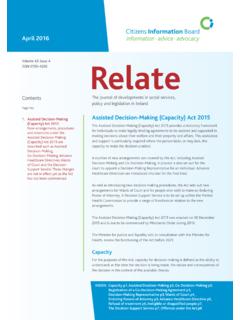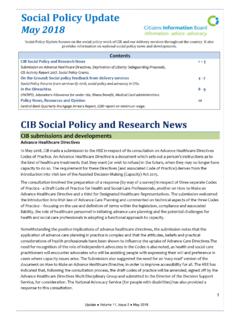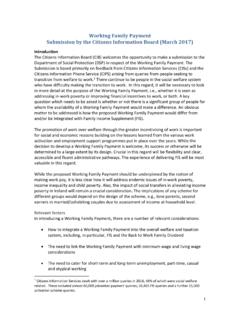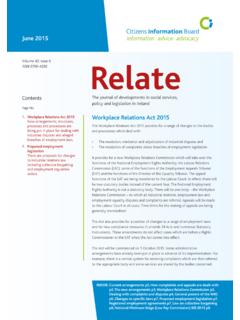Transcription of CITI058 Relate May 2014 GL - Citizens Information …
1 RelateThe journal of developments in social services, policy and legislation in IrelandMay 2014 Volume 41: Issue 5 ISSN 0790-4290 ContentsPage Legislation on local government2. The 2014 local authorities3. Local authority functions and decisions5. Local and community development6. Local enterprise offices7. Public participation in local government7. Governance of local authorities8. Rates8. Elections and bankruptcyINSIDE: Amalgamation of councils p2, Electoral areas p2, Local community development committees p5, Membership of LCDCs p5, Local community development programmes p6, Titles p7 Changes to local government and local development structures The local elections will be held on 23 May 2014. The elections to the European Parliament will be held on the same day. The number of local authorities has been reduced and there have been a number of other changes to local authority structures, powers and governance.
2 These include changes to the structures for local and community development. At the same time, the city and county enterprise boards have been replaced by local enterprise offices within the local authorities. Here we describe the main changes which have come into effect recently or will come into effect in the near future. This does not cover all aspects of local authority activity: there is a particular emphasis on who makes the decisions about local services and activities; the role of the local authorities in the promotion of enterprise; and local and community development. Legislation on local governmentThere is a wide range of legislation dealing with local government. The Local Government Acts 1925 2014 deal with their structures and powers. The Local Government Act 2001 includes some consolidation of previous legislation. The most recent legislation, the Local Government Reform Act 2014, provides for a range of changes to the organisation and work of local authorities.
3 Among other things, it provides for the amalgamation of a number of local authorities; the abolition of town councils; the abolition of city and county development boards; the establishment of local community development committees and it provides for a range of changes to the functions carried out by local authorities. It also provides for the holding of a plebiscite in Dublin on the issue of a directly elected mayor but the conditions for holding that have not been met. It deals with a number of other issues which are not covered here because our emphasis is on changes to the local authorities. The 2014 Act is very long and complex and page 2 Relate May 2014 Citizens Information Boardamends a wide range of legislation. The main changes in the Act in relation to the amalgamation and abolition of local authorities will come into effect on 1 June 2014 after the elections of 23 local authorities are also governed by legislation dealing with housing, planning and development, roads, the environment, elections and a number of other 2014 local authoritiesPlans for changes to local government structures and activities were set out in Putting People First Action Programme for Effective Local Government which was published in October 2012.
4 These plans are implemented by the 2014 will be 31 local authorities after the 2014 elections: Three city councils: Cork, Dublin and Galway Two city and county councils: Limerick and Waterford 26 county councils, of which three are in Dublin (Fingal, D n Laoghaire-Rathdown and South Dublin).Amalgamation of councilsThe 2014 Act provides for the amalgamation of the city and county councils in Limerick and Waterford, and of North Tipperary and South Tipperary County Councils. The newly amalgamated councils will be called Limerick City and County Council, Tipperary County Council and Waterford City and County and countiesCork, Dublin and Galway each retain a city council. Limerick and Waterford no longer have city councils. Kilkenny will not have a city council; the Kilkenny Borough Council is being abolished and the only local authority will be Kilkenny County councilsThe 75 town councils and the five borough councils (Clonmel, Drogheda, Kilkenny, Sligo and Wexford) are all being abolished.
5 Residents of those towns and boroughs have had a vote for those councils and also for the county council for their area. So, for example, if you live in Naas, you have had two votes in the past local elections one for Naas Town Council and one for Kildare County Council. In May 2014, you will have a vote for Kildare County Council functions carried out by these bodies will be carried out by the county council or city and county council from 1 June of local authority membersBecause of the abolition of the town and borough councils, the overall number of local authority members will be considerably reduced but there will be an increase in some areas notably the councils in Dublin. In the 2014 local elections, 949 councillors will be elected. There are 1,627 at present. Each council has at least 18 members; Dublin City Council has 63 members, Cork County Council has 55 members and the rest have between 18 and 40 members.
6 Electoral areasEach of the 31 local authority areas is divided into electoral areas. Each electoral area is entitled to elect a set number of members to the local authority. The boundaries of the local electoral areas and the number of councillors to be elected for each area were recommended in the Local Electoral Area Boundary Committee Report which was published in May 2013. The recommendations in this report are implemented in the 2014 Act. Local electoral areas and municipal district orders were made under the Act setting out the boundaries. There are 137 local electoral areas for the 31 local authorities. Website: districtsThe 2014 Act provides for the establishment of designated municipal districts. They will exist in each of the counties and city and counties outside Dublin. The local authority members elected from these municipal districts will take certain decisions in relation to the districts.
7 For example, the municipal district members will exercise some of the reserved functions in respect of their district see page 3. One or more of the electoral areas constitute a municipal district. The municipal districts which contain the areas formerly covered by Limerick, Waterford and Kilkenny city councils will be known as metropolitan districts. The municipal districts which contain the areas formerly covered by Clonmel, Drogheda, Sligo and Wexford borough councils will be known as borough districts. Municipal districts have the same legal status whether they are called municipal districts, metropolitan districts or borough county and each city and county has at least two municipal districts. There are 95 municipal districts in total. In most cases the electoral area constitutes the municipal district. However, the metropolitan districts of Limerick and Waterford (the areas formerly covered by the city councils) each have three electoral areas and the municipal districts of Dundalk, Kilkenny City, and Mullingar each have two electoral 3 Relate May 2014 Citizens Information BoardThe local authority budget will set out the amount to be allocated to the municipal districts.
8 When the overall budget is agreed, the specific amount to be allocated to each district is then decided. The municipal district members then decide how that amount is to be used. The six local authorities which will not have municipal districts the three city councils and the three Dublin counties may establish area committees but they will not have the same functions as municipal assembliesThere are eight regional authorities at present. The members are appointed by the local authorities. Their functions mainly involve the promotion of co-ordination and cohesion of services. There are two regional assemblies which were established in July 1999 to provide a structure for the two regions which were identified for the purposes of EU structural funds. The 2014 Act provides that the current regional authorities and assemblies be replaced by regional assemblies. The aim of the new assemblies will be to co-ordinate, promote or support strategic planning and sustainable development and promote effectiveness in local government and public services.
9 The number of assemblies and their boundaries have not yet been new assemblies will have a greater role in planning and economic development. Their main function will be to draw up regional spatial and economic strategies. These will replace the current regional planning guidelines and will be drawn up in conjunction with the various enterprise and economic development agencies. The existing regional planning guidelines will remain in place until these new strategies are drawn up. The 2014 Act sets out the details of how the strategies are to be authority functions and decisionsLocal authority functions are carried out by the elected members of the council, the municipal district members or the chief executive (county or city manager). Functions that may be carried out only by the elected members are known as reserved functions. The 2014 Act provides that some reserved functions may be carried out by the municipal district members, some may be carried out either by the municipal district members or the full council, and some may be carried out only by the full council.
10 The overall local authority may delegate certain functions to the municipal district members, subject to certain conditions. The delegation of functions and the revocation of any such delegation must be agreed by at least half of the total membership. There are specific functions which the local authority may not to the manager/chief executiveThe elected members have the power to give directions to the chief executive on various issues. Their power to give directions in relation to planning matters has been removed this was one of the recommendations of the Mahon Tribunal. Their power to give directions in relation to the provision of a service, finance or other form of assistance is also removed. The procedures for giving direction are also functionsThe 2014 Act lists the reserved functions of local authorities, that is, those functions which must be carried out by the elected representatives.











